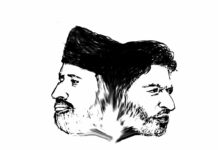Muhammad Tahir
If the two day ‘Srinagar Media Summit’ (hosted at SKICC by an NGO called Lehar), attracted headlines in Kashmir it was not only that the bigwigs from the Indian media had attended the event but that some of these famous Indian journalists displayed crude paternalistic attitude and condescending behavior, and once again reminded us that Indian civil society has not yet got itself freed from the state propagandistic idioms, and our relationship with most of its members would continue to be one of distrust and hostility.
While journalist Kuldeep Nayyar did advocate substantive autonomy for Kashmir within the Indian union but the framework of his arguments stood on politically and morally shaky grounds. He opined that granting Kashmiris their right to self determination is fraught with dangers and “For a crore or so Kashmiris, we can’t take such a risk. India won’t survive in such a scenario where there is no secularism and democracy.”
In other words, Indian secularism and democracy survives on a fragile string called Kashmir’s continued accession with the Indian Union and the moment this string is snapped, India would disintegrate. Apart from other fallacies this line of argument suffers from, there is interesting presumption it holds: that the Indian union is not indestructible, that it is a forced union thrust upon unwilling partners, that it is an unnatural union, that it is a dubious Nehruvian ‘discovery’.
Although academic Madhu Kishwar was not unlike herself when she posted that racist Tweet “In Media conference in Srinagar I faced wrath of militant Kashmiri Muslims”, but it was bound to create controversy in politically-charged Kashmir. Characterizing Kashmiris as violent and irrational has long been a characteristic feature of the Indian right wing propaganda; such negative labeling of Kashmiri Muslims is a deliberate tactic aimed at influencing public opinion in India, by sustaining the anti-Muslim discourse.
That certain events hosted in Kashmir through certain (dubious) channels will always be seen with deep suspicion and subjected to criticism proves right once again when we take a cursory glance at the reactions to the ‘Summit’ published in different Kashmir-based English newspapers. These reactions reveal, not unexpectedly, that this event too has been negatively received and portrayed. Major newspapers focused on Nayyar’s controversial remarks while most Kashmiri commentators called the summit ‘another propaganda stunt’ and came heavily down upon Nayyar and other Azadi naysayers. One editorial was telling of this peculiar reaction: “Gathering a bunch of Indian journalists to address a ‘first-ever’ media summit on Kashmir is akin to asking writers of interrogation manuals to speak on ethical treatment of prisoners”.
Such negative reactions from the Kashmiri intelligentsia are not without its good reasons. Post-2008, Indian state has encouraged or facilitated certain events in Kashmir whose aim remains to ‘engage’ Kashmiris. This engagement is seen as a measure of ‘conflict management’ (or maintenance of the status quo). An important corollary of this ‘engagement’ is dissemination of an obfuscating narrative channeled through those people whose credentials are somehow trustworthy like secular liberals (because they talk about human rights). The enterprise of obfuscation works with the aim of creating doubts and distractions in the minds of Kashmiri people so that they turn to self-doubt, self-flogging, and blame themselves for the mess created around by the occupational apparatus in Kashmir. Its instruments could be a book with selective facts (for example A.S. Dulat’s Kashmir: The Vajpayee Years), an interview (like Mani Shanker Aiyer’s interviews in Greater Kashmir, June 2011 and April 2013), events and conferences (host of them are held regularly) etc. It uses deceptive semantics and demonstrates what Paulo Friere calls ‘false generosity’ and tries to make the realities of the conflict terrifyingly opaque. Therefore, obfuscators’ politics is always perilously disruptive.















